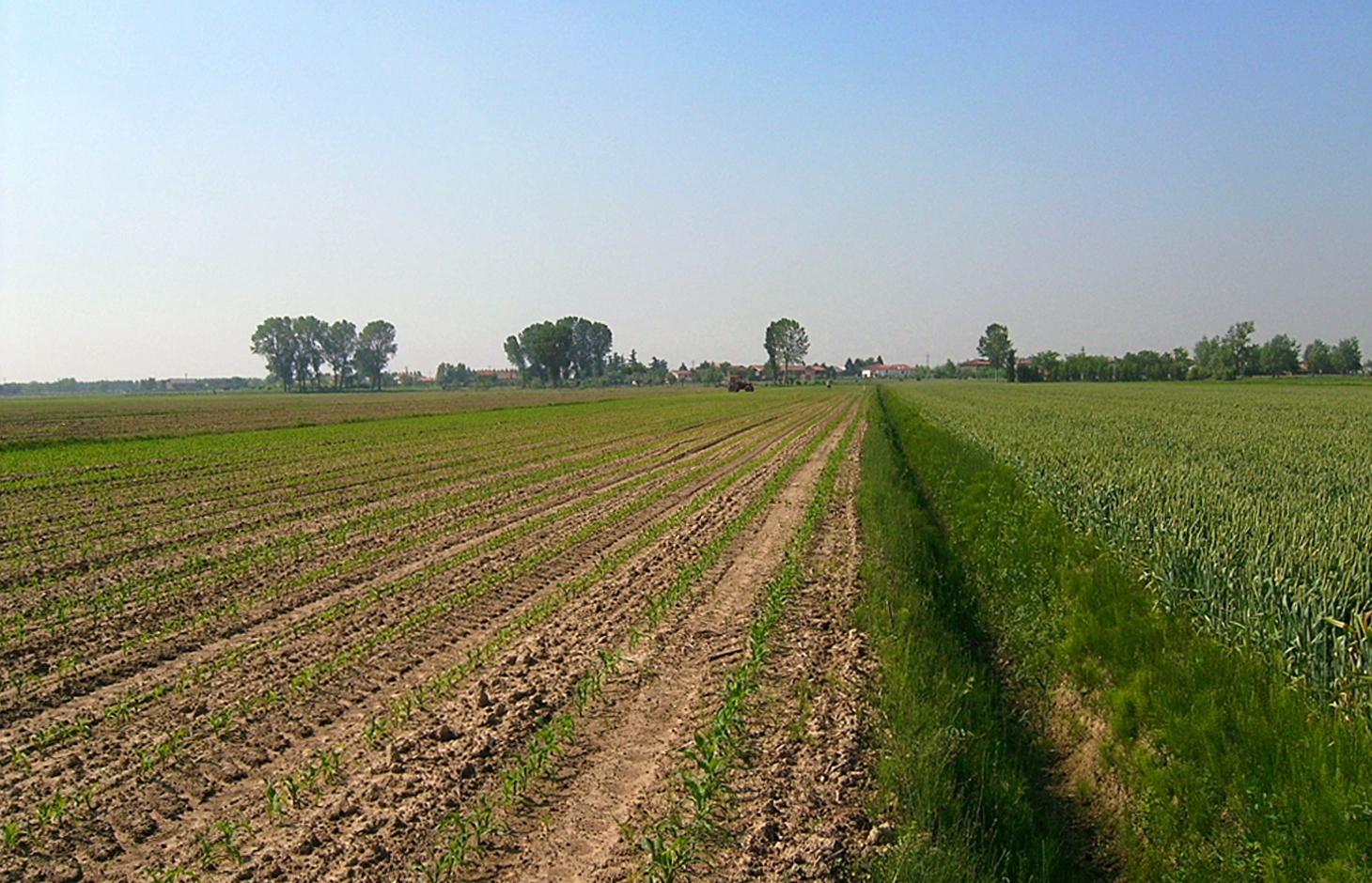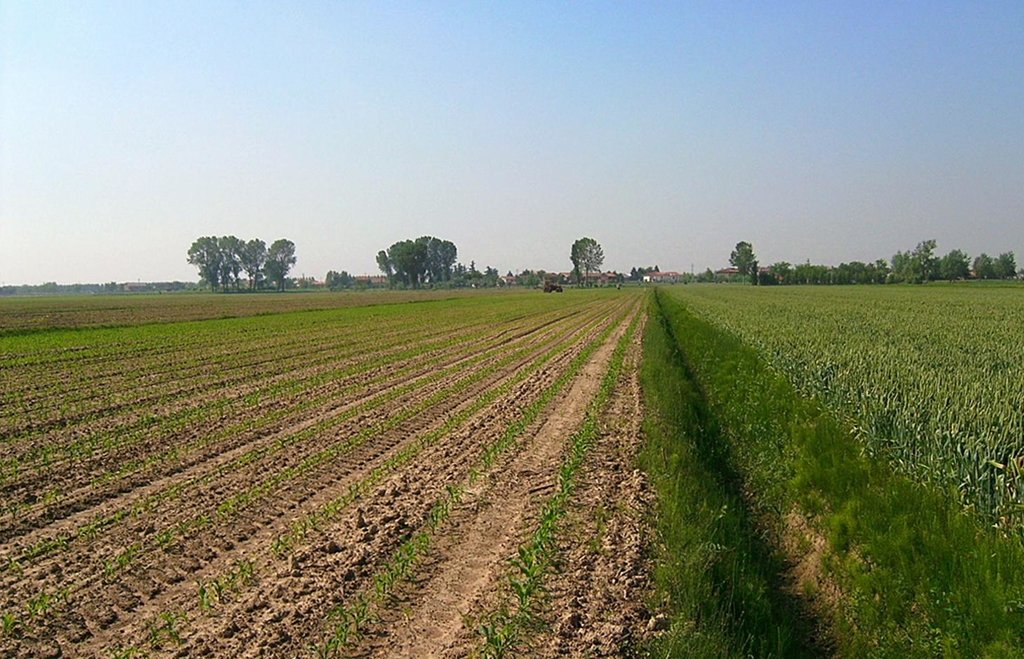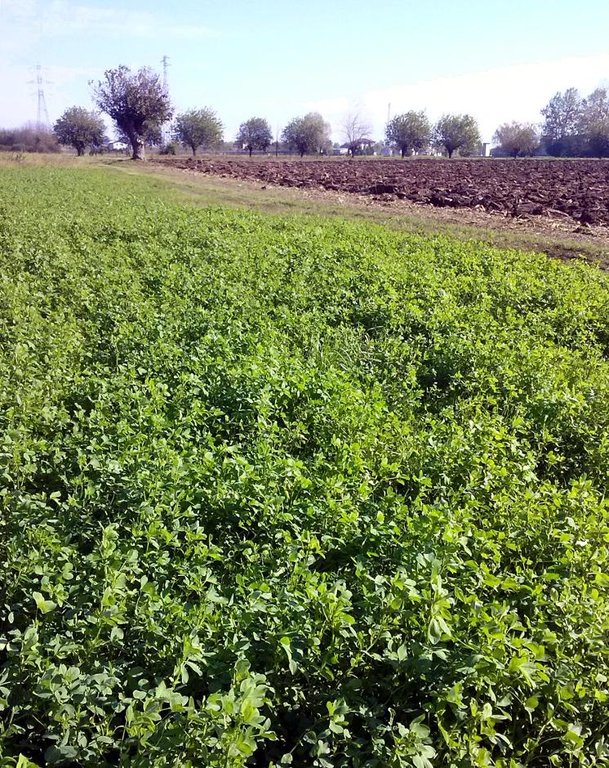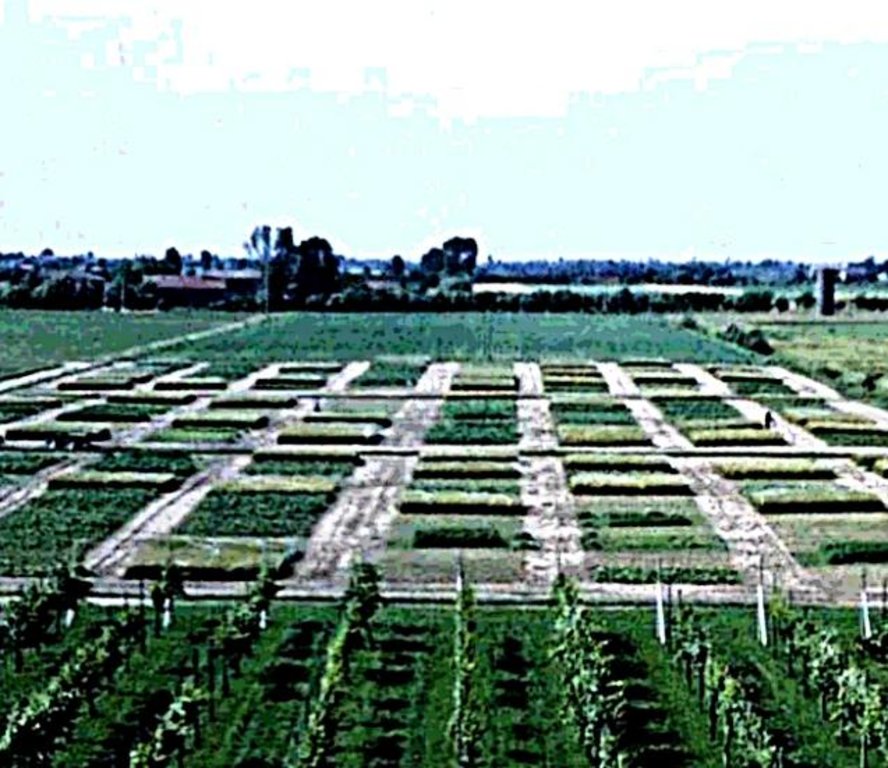Crop rotation with legumes [Italy]
- Creation:
- Update:
- Compiler: Nicola Dal Ferro
- Editor: –
- Reviewers: Fabian Ottiger, Alexandra Gavilano
Rotazione delle colture
technologies_1227 - Italy
View sections
Expand all Collapse all1. General information
1.2 Contact details of resource persons and institutions involved in the assessment and documentation of the Technology
SLM specialist:
Morari Francesco
University of Padova
Italy
Name of project which facilitated the documentation/ evaluation of the Technology (if relevant)
Preventing and Remediating degradation of soils in Europe through Land Care (EU-RECARE )Name of the institution(s) which facilitated the documentation/ evaluation of the Technology (if relevant)
University of Padova (UNIPD) - Italy1.3 Conditions regarding the use of data documented through WOCAT
The compiler and key resource person(s) accept the conditions regarding the use of data documented through WOCAT:
Yes
2. Description of the SLM Technology
2.1 Short description of the Technology
Definition of the Technology:
Crop rotation as an alternative to monoculture practices to improve soil fertility and reduce soilborne diseases
2.2 Detailed description of the Technology
Description:
Crop rotations in Veneto region, particularly in the low Venetian plain where agriculture is mainly concentrated, is diversified and based on the needs of each farmer. However most rotation systems are confined to time limits of six years or less, providing a succession of spring (generally maize, soybean, sorghum) and winter crops (wheat, rapeseed, barley). Legumes play a pivotal role on crop rotation due to their richness in protein for both man and breeding. Using legumes in the crop rotation favour the fixation of atmospheric nitrogen and bind it into the soil with a significant increase of soil fertility.
Purpose of the Technology: Crop rotation has the ability to control weeds and break pest cycles reducing the use of pesticides. Diversification of crop production increases soil and ecosystem biodiversity promoting the stability of agricultural systems. The introduction of legumes in crop rotation enhances nutrient availability and generally soil quality.
Establishment / maintenance activities and inputs: Crop rotation can be adjusted to the needs of farmers and can be adopted without significant investments and further costs. A typical crop rotation provides for the succession of deep-rooting crops (e.g. maize), winter wheat and finally soybean, which contribute to the re-establishment of soil fertility. Moreover the system allows a better distribution of labour throughout the year.
Natural / human environment: Crop rotation has many agronomic and environmental benefits compared with monoculture cropping. The increase of soil and agro-ecosystems biodiversity has positive effect on its resilience, promoting its capacity to respond to natural and anthropogenic perturbation. From an environmental point of view, the introduction of legumes favours a reduction of chemical inputs, with significant benefits for surface and groundwater quality.
2.3 Photos of the Technology
2.5 Country/ region/ locations where the Technology has been applied and which are covered by this assessment
Country:
Italy
Region/ State/ Province:
Italy
Further specification of location:
Low venetian plain of veneto region
Specify the spread of the Technology:
- evenly spread over an area
If precise area is not known, indicate approximate area covered:
- 1,000-10,000 km2
2.6 Date of implementation
If precise year is not known, indicate approximate date:
- more than 50 years ago (traditional)
2.7 Introduction of the Technology
Specify how the Technology was introduced:
- as part of a traditional system (> 50 years)
3. Classification of the SLM Technology
3.1 Main purpose(s) of the Technology
- improve production
- reduce, prevent, restore land degradation
3.2 Current land use type(s) where the Technology is applied

Cropland
- Annual cropping
Annual cropping - Specify crops:
- cereals - maize
- cereals - wheat (winter)
- fodder crops - alfalfa
- legumes and pulses - soya
- root/tuber crops - sugar beet
Specify:
Longest growing period in days: 210 Longest growing period from month to month: March to OctoberSecond longest growing period in days: 180
Is crop rotation practiced?
Yes
If yes, specify:
Rotations / fallows
Material/ species: Cereals, Legumes, Brassicaceae
A typical crop rotation provides for the succession of deep-rooting crops (e.g. maize), winter wheat and finally soybean, which contribute to the re-establishment of soil fertility
Comments:
Main crops: maize, wheat, soybean, alfalfa, sugar beet.
Major land use problems (compiler’s opinion): Soils in the low Venetian plain of the Veneto region generally suffer from a loss of soil organic matter (SOM) that is strongly affected by their natural texture and climatic conditions. Moreover, in the last 50 years intensive tillage practices contributed to a further SOM decrease estimated at 0.02-0.58 t/ha/y of carbon and high intensive monoculture practices implied oversimplification of agro-ecosystems and decline of soil biodiversity.
Major land use problems (land users’ perception): Decrease of productivity. However to date, few farmers have adopted conservation practices in order to reduce a decline of soil fertility and water quality, symptom of poor perception of the problem.
3.4 Water supply
Water supply for the land on which the Technology is applied:
- mixed rainfed-irrigated
Comments:
Water supply: Also rainfed, full irrigation
3.5 SLM group to which the Technology belongs
- rotational systems (crop rotation, fallows, shifting cultivation)
3.6 SLM measures comprising the Technology

agronomic measures
- A2: Organic matter/ soil fertility

management measures
- M2: Change of management/ intensity level
Comments:
Main measures: agronomic measures
Secondary measures: management measures
Type of agronomic measures: rotations / fallows
3.7 Main types of land degradation addressed by the Technology

chemical soil deterioration
- Cn: fertility decline and reduced organic matter content (not caused by erosion)

biological degradation
- Bl: loss of soil life
- Bp: increase of pests/ diseases, loss of predators
Comments:
Main type of degradation addressed: Cn: fertility decline and reduced organic matter content, Bl: loss of soil life, Bp: increase of pests / diseases, loss of predators
Main causes of degradation: soil management (lack of organic input with fertilisations), population pressure (High demand for agricultural products and competition for land in densely populated area)
Secondary causes of degradation: crop management (annual, perennial, tree/shrub) (crop monoculture instead of crop rotation)
3.8 Prevention, reduction, or restoration of land degradation
Specify the goal of the Technology with regard to land degradation:
- prevent land degradation
- reduce land degradation
Comments:
Main goals: mitigation / reduction of land degradation
Secondary goals: prevention of land degradation
4. Technical specifications, implementation activities, inputs, and costs
4.1 Technical drawing of the Technology
Technical specifications (related to technical drawing):
Crop rotation experiment established at the University of Padova (1962) including a comparison of monocultures and true rotations (two-year, four-year, six-year). Cropping systems include maize, wheat, soybean, alfalfa, sugar beet.
Location: Legnaro. Padova - Italy
Technical knowledge required for field staff / advisors: low
Technical knowledge required for land users: high
Main technical functions: increase in nutrient availability (supply, recycling,…), spatial arrangement and diversification of land use
Secondary technical functions: increase in organic matter
Rotations / fallows
Material/ species: Cereals, Legumes, Brassicaceae
4.2 General information regarding the calculation of inputs and costs
other/ national currency (specify):
Euro €
If relevant, indicate exchange rate from USD to local currency (e.g. 1 USD = 79.9 Brazilian Real): 1 USD =:
0.8
Indicate average wage cost of hired labour per day:
21.00
4.3 Establishment activities
Comments:
No initial investment
4.5 Maintenance/ recurrent activities
| Activity | Timing/ frequency | |
|---|---|---|
| 1. | Tillage | |
| 2. | Seedbed preparation and sowing | |
| 3. | Fartilisations | |
| 4. | Weed control | |
| 5. | Harvesting |
4.6 Costs and inputs needed for maintenance/ recurrent activities (per year)
| Specify input | Unit | Quantity | Costs per Unit | Total costs per input | % of costs borne by land users | |
|---|---|---|---|---|---|---|
| Equipment | Tillage | ha | 1.0 | 190.5 | 190.5 | |
| Equipment | Seedbed preparation and sowing | ha | 1.0 | 190.5 | 190.5 | |
| Equipment | Weed control | ha | 1.0 | 89.0 | 89.0 | |
| Equipment | Harvesting | ha | 1.0 | 153.0 | 153.0 | |
| Plant material | Seeds | ha | 1.0 | 190.5 | 190.5 | |
| Fertilizers and biocides | Fertilizer | ha | 1.0 | 406.0 | 406.0 | |
| Fertilizers and biocides | Biocides | ha | 1.0 | 125.0 | 125.0 | |
| Total costs for maintenance of the Technology | 1344.5 | |||||
| Total costs for maintenance of the Technology in USD | 1680.63 | |||||
4.7 Most important factors affecting the costs
Describe the most determinate factors affecting the costs:
Costs consider a three-year crop rotation with a succession of maize, wheat and soybean. There are not establishment inputs and costs because all the costs are recurrent. Main expenses are for machinery and fertilisations
5. Natural and human environment
5.1 Climate
Annual rainfall
- < 250 mm
- 251-500 mm
- 501-750 mm
- 751-1,000 mm
- 1,001-1,500 mm
- 1,501-2,000 mm
- 2,001-3,000 mm
- 3,001-4,000 mm
- > 4,000 mm
Agro-climatic zone
- sub-humid
Thermal climate class: temperate
5.2 Topography
Slopes on average:
- flat (0-2%)
- gentle (3-5%)
- moderate (6-10%)
- rolling (11-15%)
- hilly (16-30%)
- steep (31-60%)
- very steep (>60%)
Landforms:
- plateau/plains
- ridges
- mountain slopes
- hill slopes
- footslopes
- valley floors
Altitudinal zone:
- 0-100 m a.s.l.
- 101-500 m a.s.l.
- 501-1,000 m a.s.l.
- 1,001-1,500 m a.s.l.
- 1,501-2,000 m a.s.l.
- 2,001-2,500 m a.s.l.
- 2,501-3,000 m a.s.l.
- 3,001-4,000 m a.s.l.
- > 4,000 m a.s.l.
Comments and further specifications on topography:
Altitudinal zones: 0-100 m a.s.l. (the low Venetian does not exceed 50 m above sea level)
5.3 Soils
Soil depth on average:
- very shallow (0-20 cm)
- shallow (21-50 cm)
- moderately deep (51-80 cm)
- deep (81-120 cm)
- very deep (> 120 cm)
Soil texture (topsoil):
- medium (loamy, silty)
Topsoil organic matter:
- medium (1-3%)
- low (<1%)
If available, attach full soil description or specify the available information, e.g. soil type, soil PH/ acidity, Cation Exchange Capacity, nitrogen, salinity etc.
Soil fertility is low-medium
Soil drainage/infiltration is medium
Soil water storage capacity is medium
5.4 Water availability and quality
Ground water table:
< 5 m
Availability of surface water:
good
Water quality (untreated):
good drinking water
Comments and further specifications on water quality and quantity:
Ground water table: <5m (The area surrounding the Venice lagoon (1240 km2) is even below the sea level (down to -2 m) and currently cultivated due to land reclamation. As a result water table is kept artificially low)
Water quality (untreated) is good drinking water (groundwater) and for agriculutral use only (irrigation with surface water)
5.5 Biodiversity
Species diversity:
- medium
Comments and further specifications on biodiversity:
High population density, infrastructures and intensive agriculture practices affect the state of biodiversity.
5.6 Characteristics of land users applying the Technology
Market orientation of production system:
- mixed (subsistence/ commercial)
- commercial/ market
Off-farm income:
- 10-50% of all income
Relative level of wealth:
- average
Individuals or groups:
- individual/ household
Level of mechanization:
- mechanized/ motorized
Gender:
- men
Indicate other relevant characteristics of the land users:
Land users applying the Technology are mainly common / average land users
Difference in the involvement of women and men: Farmers in the Veneto region are traditionally males due to historical and cultural reasons.
Population density: 200-500 persons/km2
Annual population growth: 0.5% - 1%
100% of the land users are average wealthy.
5.7 Average area of land used by land users applying the Technology
- < 0.5 ha
- 0.5-1 ha
- 1-2 ha
- 2-5 ha
- 5-15 ha
- 15-50 ha
- 50-100 ha
- 100-500 ha
- 500-1,000 ha
- 1,000-10,000 ha
- > 10,000 ha
Is this considered small-, medium- or large-scale (referring to local context)?
- medium-scale
Comments:
Average area of land owned or leased by land users applying the Technology: Also 15-50 ha, 50-100 ha, 100-500 ha
5.8 Land ownership, land use rights, and water use rights
Land ownership:
- individual, not titled
Land use rights:
- leased
- individual
5.9 Access to services and infrastructure
health:
- poor
- moderate
- good
education:
- poor
- moderate
- good
technical assistance:
- poor
- moderate
- good
employment (e.g. off-farm):
- poor
- moderate
- good
energy:
- poor
- moderate
- good
roads and transport:
- poor
- moderate
- good
drinking water and sanitation:
- poor
- moderate
- good
financial services:
- poor
- moderate
- good
6. Impacts and concluding statements
6.1 On-site impacts the Technology has shown
Socio-economic impacts
Production
crop production
risk of production failure
product diversity
Income and costs
expenses on agricultural inputs
diversity of income sources
workload
Socio-cultural impacts
SLM/ land degradation knowledge
Improved livelihoods and human well-being
Comments/ specify:
In the long-term the technology maintains soil fertility and reduces pest diseases. Moreover, it contriobutes to differentiate yields and markets.
Ecological impacts
Soil
nutrient cycling/ recharge
soil organic matter/ below ground C
Biodiversity: vegetation, animals
plant diversity
6.3 Exposure and sensitivity of the Technology to gradual climate change and climate-related extremes/ disasters (as perceived by land users)
Gradual climate change
Gradual climate change
| Season | increase or decrease | How does the Technology cope with it? | |
|---|---|---|---|
| annual temperature | increase | not well |
Other climate-related consequences
Other climate-related consequences
| How does the Technology cope with it? | |
|---|---|
| reduced growing period | not well |
6.4 Cost-benefit analysis
How do the benefits compare with the maintenance/ recurrent costs (from land users' perspective)?
Short-term returns:
neutral/ balanced
Long-term returns:
positive
6.5 Adoption of the Technology
Of all those who have adopted the Technology, how many did so spontaneously, i.e. without receiving any material incentives/ payments?
- 91-100%
Comments:
100% of land user families have adopted the Technology without any external material support
6.7 Strengths/ advantages/ opportunities of the Technology
| Strengths/ advantages/ opportunities in the land user’s view |
|---|
|
Maintains soil fertility How can they be sustained / enhanced? Targeted funding |
| Enhances nutrient cycling |
| Strengths/ advantages/ opportunities in the compiler’s or other key resource person’s view |
|---|
|
Maintains soil fertility and biodiversity How can they be sustained / enhanced? Encourages the use of legumes |
|
Enhances nutrient cycling How can they be sustained / enhanced? Application of organic manure instead of chemical fertilizers |
|
Reduces external inputs How can they be sustained / enhanced? Encourages the use of legumes |
6.8 Weaknesses/ disadvantages/ risks of the Technology and ways of overcoming them
| Weaknesses/ disadvantages/ risks in the land user’s view | How can they be overcome? |
|---|---|
| Doeas not maximise yields and incomes |
| Weaknesses/ disadvantages/ risks in the compiler’s or other key resource person’s view | How can they be overcome? |
|---|---|
| Increases labour constraints | Support farmers on field management |
7. References and links
7.1 Methods/ sources of information
7.2 References to available publications
Title, author, year, ISBN:
Productivity and Sustainability of Different Cropping Systems. 40 years of Experiments in Veneto region (Italy), Giardini L., 2004
Links and modules
Expand all Collapse allLinks
No links
Modules
No modules





